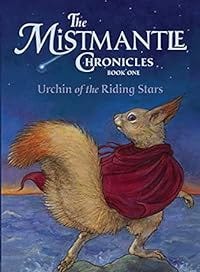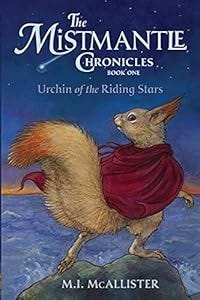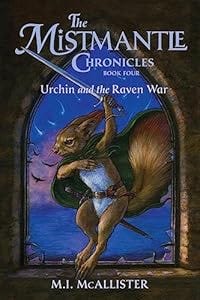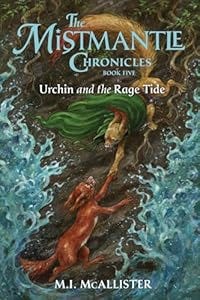Sometimes reading children’s fiction is a slog because everything seems to be poorly written, is unbelievable, and is full of elements that are repeated all over contemporary fiction these days. In fact, it leads one to wonder whether the author was given a list that is regularly circulated among the major publishing houses and from which the author must select one item from List A or two from List B.
This is not a review of one of those books.
This is a post about the exact opposite experience, in fact. The Mistmantle Chronicles series by M.I. McAllister was published in the mid-to-late 2000s; the five books that comprise the series are devoid of any of the box-checking elements that have become so common in mainstream children’s fiction. The Mistmantle worldbuilding is fundamentally Christian and the themes are fundamentally Christian, but not so much so that the story itself becomes unenjoyable (a different kind of box-checking, which is also cringe-inducing and which I frequently find in contemporary Christian fiction). You can read the Mistmantle books purely for the adventures, the anthropomorphic animals, and the magic, and not even think about the underlying Christian themes.
The series is set on the island of Mistmantle, which is encircled by enchanted mists that protect the island and all its inhabitants—so long as they do not go beyond the mists more than twice. The books center around a young orphan squirrel, Urchin, as well as his closest friends and his mentors as they deal with various adversities that threaten the island’s peace, safety, and prosperity. The series stretches over an indeterminate number of years, but we see Urchin and his friends grow from young animals into adults, from apprentices and helpers into the next generation of leaders on the island.
One of the first things I noticed is that there is no moral ambiguity in this series. The good guys are good, although they make mistakes; the bad guys are almost cartoonishly evil. But this in itself is a not a bad thing. Eight-to-twelve-year-old children, who are the target audience for this series, have a strong sense of justice and want to see the world laid out in black and white. And, as I am always telling people, children need to know what black and white are before they can begin to understand the shades of gray. (Plus, it occurred to me while I was reading this series that my eight-year-old, voracious reader though he may be, hasn’t read enough books yet to know something is a cliché when he encounters it! How much reading do you think it takes for someone to start noticing clichés?)
The good guys in the Mistmantle world always win in the end, and the bad guys get what they deserve. (In one case, a priest literally exorcises the darkness from a pit of evil and replaces it with healing and light.) In most cases, however, the villains suffer from the perfectly-timed consequences of their own actions, such as when a noblewoman who has been poisoning the queen with “special medicine” is mistakenly given the same poison by her unhealthily-loyal young servant, who believes it really is a special medicine. (This is another theme in this book—the young animals who follow or learn from virtuous adults have much better outcomes than the young who follow or idolize the vicious ones.)
McAllister does not shy away from addressing dark or heavy themes in these novels. Although nothing is very graphic, there are elements that may be too much for some children. Here are some examples: Urchin’s mother dies after giving birth to him, alone, on the shores of Mistmantle (we later learn she was fleeing oppression and persecution); a toddler prince is murdered in cold blood by being stabbed, and the nature of his death is referenced repeatedly after the fact; the villain in book one has established a series of “cullings” that kill off newborn animals who have physical deformities; a villain keeps the king drunk as much as possible because the king is groggy, slow-witted, and easily influenced when he is drunk; a self-proclaimed sorcerer pokes around the insides of sacrificed animals to make prophecies, and he is desperate to sacrifice Urchin and poke around his insides; there are several kidnappings and characters gone-missing-presumed-dead that form the plot of specific books in the series. Additionally, several characters—including major ones—die over the course of the series. They die from nearly all possible causes: from old age, from illness, in battle, by treachery. (But not torture.) Some deaths come as a shock and some take much longer. In the final book we even get a character knowingly sacrificing his own life, by crossing the mists for the forbidden third time, in order to save another character’s life. (Remember how I said the series was fundamentally Christian?)
While there are darker themes, there is also wisdom and philosophy nestled in the pages of these books. The stakes are high and real and there’s plenty of adventure, but there are also lessons learned and wisdom imparted about human nature and the development of virtue. Sometimes the enemy is not only an army of bloodthirsty ravens coming to kill and devour everything in their path, but the enemy is also the fear and distrust in our own hearts.
I think this is an excellent series and I wish it was more widely known. I’ve said it before and I will say it again now: I think The Mistmantle Chronicles is a good example of how to write good children’s fiction that is Christian without falling into the trap of becoming Christian Children’s Fictiontm. It’s a good story, first and foremost.
Below are my (short) hot takes on each individual book.
Urchin of the Riding Stars
Urchin is an orphan of unknown origins, who becomes a page at the king’s court and helps stop the attempted usurpation of the throne. I predicted much of this, but I also developed an affinity for the adult protagonists, and they kept me coming back for more.
Urchin and the Heartstone
Urchin gets kidnapped and taken to Whitewings, another island, where he is kept prisoner because the crazy (and illegitimate) king thinks that Urchin will lead them to find silver that the king’s subjects can mine. The evil magician wants to sacrifice Urchin and use his body for black magic in order to conquer other islands.
I thought the villain’s demise in this book was especially fitting.
The Heir of Mistmantle
A squirrel who has lost her mind kidnaps the infant princess (in the interest of protecting her) and while the search for her stretches on and on, a drought and a plague sweep across the island. The hot and sick animals start letting rumors fly about a previous (unconfirmed dead) villain somehow coming back.
I like the message about fear and rumors in this book.
Urchin and the Raven War
After King Crispin and the Mistmantlers help a neighboring island repulse an invasive and oppressive force of ravens, the surviving ravens draw together an even larger army and descend upon Mistmantle with the intention of destroying the island and eradicating all of its inhabitants.
The main plot of this book was my personal favorite, I guess due to the existential threat and the fact that I couldn’t predict how the heroes were going to defeat the villains.
Urchin and the Rage Tide
I felt let down by the plot of this final book in the series: a “rage tide,” which functions sort of like a tsunami and a storm surge, damages the island and sweeps away one of Urchin’s best friends. She is missing and presumed dead; whether and how to try to find her beyond the protective barrier of mists is one of the main tensions of the book.
I did not give a fig about that plot: I was disappointed by it after the very high stakes of Raven War. I was most invested in the tying up of any loose threads and the ultimate self-sacrifice that doubled as the goodbye for the whole series. The ending was bittersweet.









This is an excellent review!! I was searching for this series and found your post :)